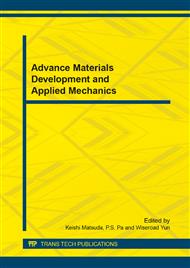[1]
P. Ricci, F. De Luca, GM. Verderame: 6th April 2009 L'Aquila earthquake, Italy: Reinforced concrete building performance. Bull Earthquake Eng (2011), 9(1): 285–305.
DOI: 10.1007/s10518-010-9204-8
Google Scholar
[2]
A. Masi, G. Santarsiero, M.R. Gallipoli, M. Mucciarelli, V. Manfredi, A. Dusi, T. A. Stabile: Performance of the health facilities during the 2012 Emilia (Italy) earthquake and analysis of the Mirandola hospital case study. Bull. Earthquake Eng (in press). DOI: 10. 1007/s10518-013-9518-4.
DOI: 10.1007/s10518-013-9518-4
Google Scholar
[3]
Ministerial Decree 14 January 2008: Technical Norms for Constructions, 2008, (in Italian).
Google Scholar
[4]
CEN: Eurocode 8: Design of structures for earthquake resistance, Part 3: Assessment and retrofitting of buildings. June 2004, Doc. CEN/TC250/SC8/N388B. Comité Européen de Normalisation, Bruxelles (2004).
Google Scholar
[5]
FEMA 356: Prestandard and commentary for the seismic rehabilitation of buildings. Federal Emergency Management Agency, Washington D.C., November (2000).
Google Scholar
[6]
H. Crowley, M. Colombi, B. Borzi, M. Faravelli, M. Onida, M. Lopez, D. Polli, F. Meroni, R. Pinho: A comparison of seismic risk maps for Italy. Bull Earthquake Eng. (2009) 7: 149-180 DOI 10. 1007/s10518-008-9100-7.
DOI: 10.1007/s10518-008-9100-7
Google Scholar
[7]
INGV-DPC S1: Continued assistance to the DPC for the completion and management of seismic hazard maps foreseen in the Ordinance PCM 3274 and planning of future developments. http: /esse1. mi. ingv. it (in Italian) (2007).
Google Scholar
[8]
M. Stucchi, C. Meletti, V. Mondaldo, H. Crowley, G.M. Calvi, E. Boschi: Seismic Hazard Assessment (2003-2009) for the Italian Building Code. Bull. Seismol. Soc. Am. (2011) 101(4), 1885-(1911).
DOI: 10.1785/0120100130
Google Scholar
[9]
G.M. Verderame, G. Manfredi, G. Frunzio: Le proprietà meccaniche dei calcestruzzi impiegati nelle strutture in c. a. realizzate negli anni 60. In: Proceedings of the 10th Conference on "Earthquake Engineering in Italy, Potenza-Matera, 9-13 September 2001, (in Italian).
Google Scholar
[10]
G.M. Verderame, A. Stella, E. Cosenza: Le proprietà meccaniche degli acciai impiegati nelle strutture in cemento armato realizzate negli anni 60. In: Proc. of the 10th Conference on "Earthquake Engineering in Italy, Potenza-Matera, 9-13 September 2001, (in Italian).
Google Scholar
[11]
M. Ferrini, N. Signorini, P. Pelliccia, F. Pistola, V. Prestifilippo, G. Sabia: La metodologia della Regione Toscana per la valutazione della resistenza del calcestruzzo di edifici esistenti in cemento armato. In: Proc. of the Conference Valutazione e riduzione della vulnerabilità sismica di edifici in cemento armato, Roma, 2008, (in Italian).
DOI: 10.36253/bsgi-1453
Google Scholar
[12]
M. Ferrini, N. Signorini, P. Pelliccia, F. Pistola, V. Prestifilippo, G. Sabia: Risultati delle campagne d'indagine svolte dalla Regione Toscana per la valutazione della resistenza del calcestruzzo di edifici esistenti in cemento armato. In: Proc. of the conference Valutazione e riduzione della vulnerabilità sismica di edifici in cemento armato, Roma, 2008, (in Italian).
DOI: 10.36253/bsgi-1453
Google Scholar
[13]
A. Masi, M. Vona: Estimation of the in-situ concrete strength: provisions of the European and Italian seismic codes and possible improvements. In: Proc. of the Workshop Eurocode 8 Perspectives from the Italian Standpoint, (E. Cosenza Ed. ), 67-77, 2009, Naples, Italy.
Google Scholar
[14]
OPCM 3431 3 May 2005: Further modifications and integrations of the OPCM 3274 of the 20 March 2003, 2005, (in Italian).
Google Scholar
[15]
A. Masi, L. Chiauzzi: An experimental study on the within-member variability of in situ concrete strength in RC building structures. Construction and Building Materials. 47: 951-961. (2013).
DOI: 10.1016/j.conbuildmat.2013.05.102
Google Scholar
[16]
FEMA 274: NEHRP commentary on the guidelines for the seismic rehabilitation of buildings. Federal Emergency Management Agency, 1997. Washington, D. C.
Google Scholar
[17]
Royal Decree n. 2229: Design code of reinforced concrete structures, 1939, (in Italian).
Google Scholar
[18]
Ministerial Decree 30 May 1972: Design code of reinforced concrete, prestressed concrete and steel structures, 1972, (in Italian).
Google Scholar
[19]
Ang A.H.S., Tang W.H.: Probability Concepts in Engineering (2nd Edition), John Wiley & Sons, (2007).
Google Scholar


